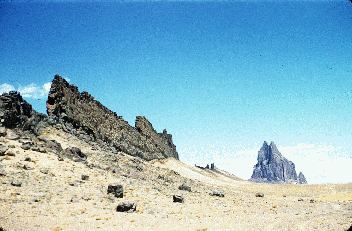14.5.2: Igneous Rocks
- Page ID
- 16165
Igneous rocks form by the cooling of magma (molten rock material beneath the surface) or lava (molten rock material extruded onto the surface). Magma which originates at depths as great as 200 kilometers below the surface consists primarily of elements found in silicate minerals along with gases, notably water vapor. Because the molten material is less dense than the surrounding solidified rock, it works its way toward the surface where it flows out onto the surface as lava.
Cooling of the magma initiates the crystallization of elements contained within the molten rock. Usually, cooling does not take place at the same rate throughout the entire mass. As it cools, numerous small crystal develop and then ions are added around these centers of growth. Once the crystals grow enough for their edges to meet, growth ceases and crystallization commences in another part of the mass. Over time the magma cools into a solidified rock of interlocking crystals. The rate of cooling determines the degree to which crystals can grow. Those that form by slow cooling have large crystals and are described as being coarse-grained. Fine-gained igneous rocks form by more rapidly cooling when the molten material is exposed at the surface. As a result, crystals don't have a chance to grow very large.
Intrusive Igneous Rock
When magma intrudes into pre-existing rock it cools rather slowly because the surrounding host or country rock, as it is called, insulates the magma. As a result, crystals grow larger giving the rock mass a coarse texture. Such intrusive igneous, or plutonic rocks where the mineral grains are easily seen with the unaided eye are called porphyritic. The rock mass itself is called a pluton.

Physical geographers are especially interested in rocks that form beneath the surface after they have been exposed by erosion of the overlying host rock. A batholith is a huge intrusive igneous rock mass or pluton that when uncovered creates topographic highs in mountainous regions. The Idaho Batholith for example covers some 16,000 square miles. These landforms are massive in character lacking linear ridges and valleys.

When magma intrudes between the layers or rock and solidifies it creates a feature called a sill. Sills form a hogback or cuesta when the layer of rock is dipping, or the tops of mesas when lying horizontal. If the magma solidifies as a pocket of igneous rock that warps the overlying rock it will form a dome or laccolith. The Black Hills of South Dakota is such a domal feature. If magma cools in near vertical fractures a dike is formed ![]() . Dikes often form on the flanks of volcanoes. When exposed by erosion they take the form of a linear ridge. Shiprock, New Mexico a volcanic neck (Figure \(\PageIndex{4}\)), has several dikes radiating away from it.
. Dikes often form on the flanks of volcanoes. When exposed by erosion they take the form of a linear ridge. Shiprock, New Mexico a volcanic neck (Figure \(\PageIndex{4}\)), has several dikes radiating away from it.

Extrusive Igneous Rocks
Fine-grained rocks form if molten rock cools rapidly when it is extruded onto the surface. Basalt is a common extrusive igneous rock. Some fine grained rocks forming at the edge of a lava flow have small holes or vesicles which are void spaces left by escaping gasses. Very rapid cooling can produce rocks with a glassy texture such as obsidian.



